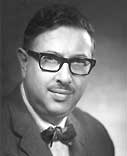Stanley Garn
Stanley Garn, professor emeritus of nutrition in the School of Public Health, professor emeritus of anthropology in LSA and emeritus fellow in the Center for Human Growth and Development, died of complications from peripheral vascular disease on Aug. 31 in Ann Arbor. He was 84.

Garn was a prolific author and researcher, authority on a multitude of topics in human biology, and an engaging personality with a wide acquaintance at the University, former colleagues say. He was elected to the National Academy of Sciences in 1976, and in 1988 the American Association of Physical Anthropologists honored him with their Charles R. Darwin Lifetime Achievement Award. In 2002 the Human Biology Council honored him with the Franz Boas award.
Garn, born Oct. 27, 1922 in New London, Conn., studied anthropology at Harvard University (A.B. ’42, A.M. ’47 and Ph.D. ’48), with a cohort of students who would found most of the country’s Ph.D. programs in physical anthropology. Garn’s dissertation on human hair was the first of his many contributions to human biology.
Garn’s practical skills let him move easily from research to shop or laboratory. During 1942-44 he was a research associate in chemical engineering at the Chemical Warfare Service of the Massachusetts Institute of Technology, where he designed gas masks to fit the variety of faces of service men and women. During 1946-47 Garn worked as a technical editor at the Polaroid Corp. He undertook primary field research in the Aleutian Islands on a medical and anthropological expedition in 1948.
In 1952 he joined the departments of Physical Growth and Genetics at the Fels Research Institute in Yellow Springs, Ohio, and was appointed in the Anthropology Department at Antioch College. Fels was the center for what became the largest and longest continuous study of human growth in the world. There, Garn produced landmark studies of fat and fat patterning, skeletal maturation, anthropometrics, and the gain and loss of bone tissue with age. His work on tooth calcification and eruption in Fels subjects made him one of the founders of the field of dental anthropology. His book “Human Races” (1961), attempted to show the shallow knowledge of human diversity and to put the concept in a scientific context of geographic variation and evolution.
The Center for Human Growth and Development recruited Garn in the late 1960s, uniting him with colleagues with similar interests. During his tenure, from 1968 to his retirement in 1992, Garn investigated development of bones and teeth, anthropometrics, fatness, serum markers, fetal development, pregnancy, birth weight and the familial, economic and nutritional factors that affected them. His productivity also was legendary, amounting to more than 800 publications; these included both books and review articles, but primarily consisted of original research.
Garn was a hands-on teacher who instructed graduate students in every aspect of scientific research and publication. He was unfailingly enthusiastic about science and research, and generous with his time and attention, students say.
Survivors include his wife, Priscilla Crozier Garn, children Barbara and Bill Garn of California, and brother-in-law Professor C. Loring Brace of U-M. A memorial service is set for 2 p.m. Sept. 29 at the Glacier Hills Retirement Community, Kaye Hansen Room, 1200 Earhart Road, Ann Arbor, MI 48105.

